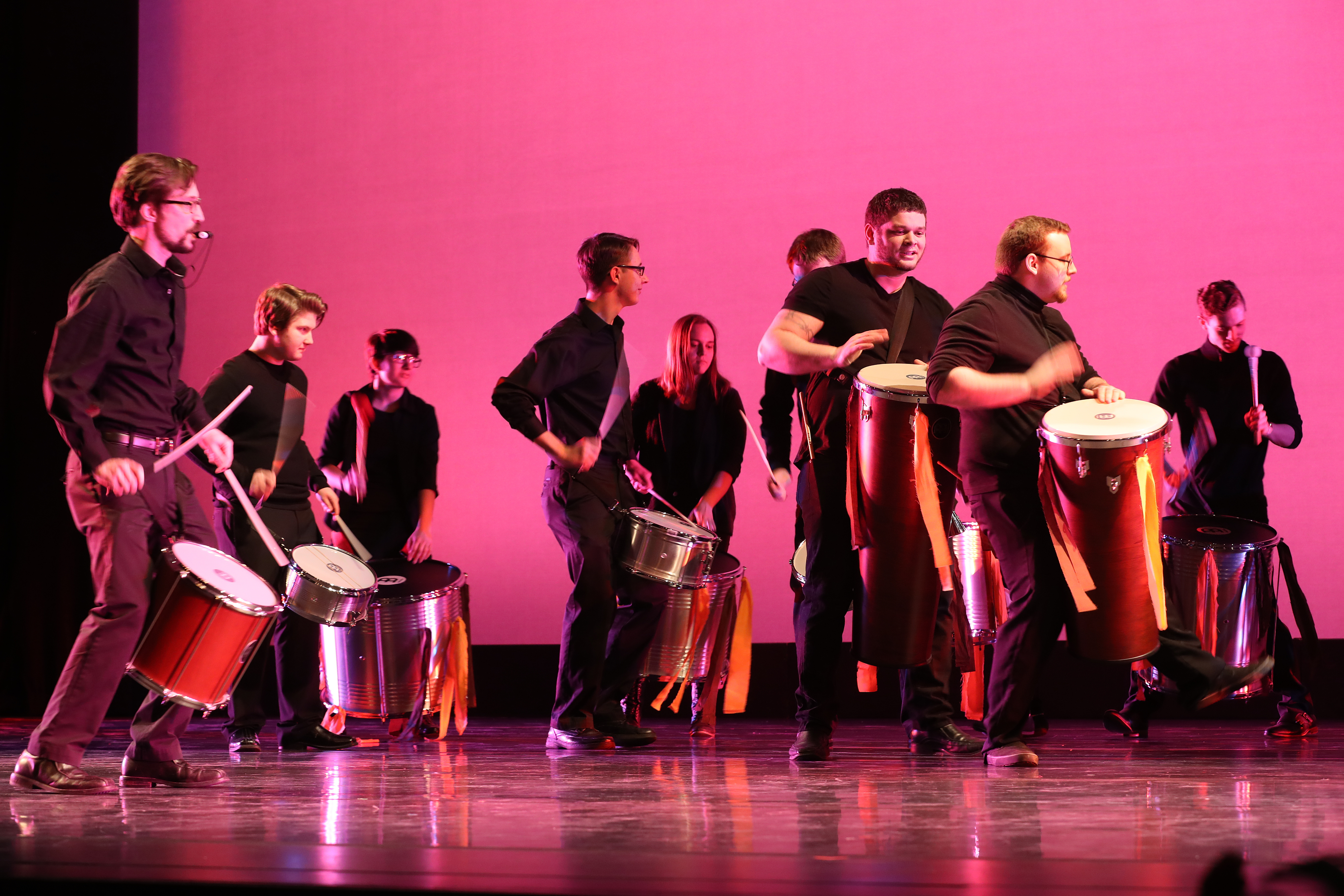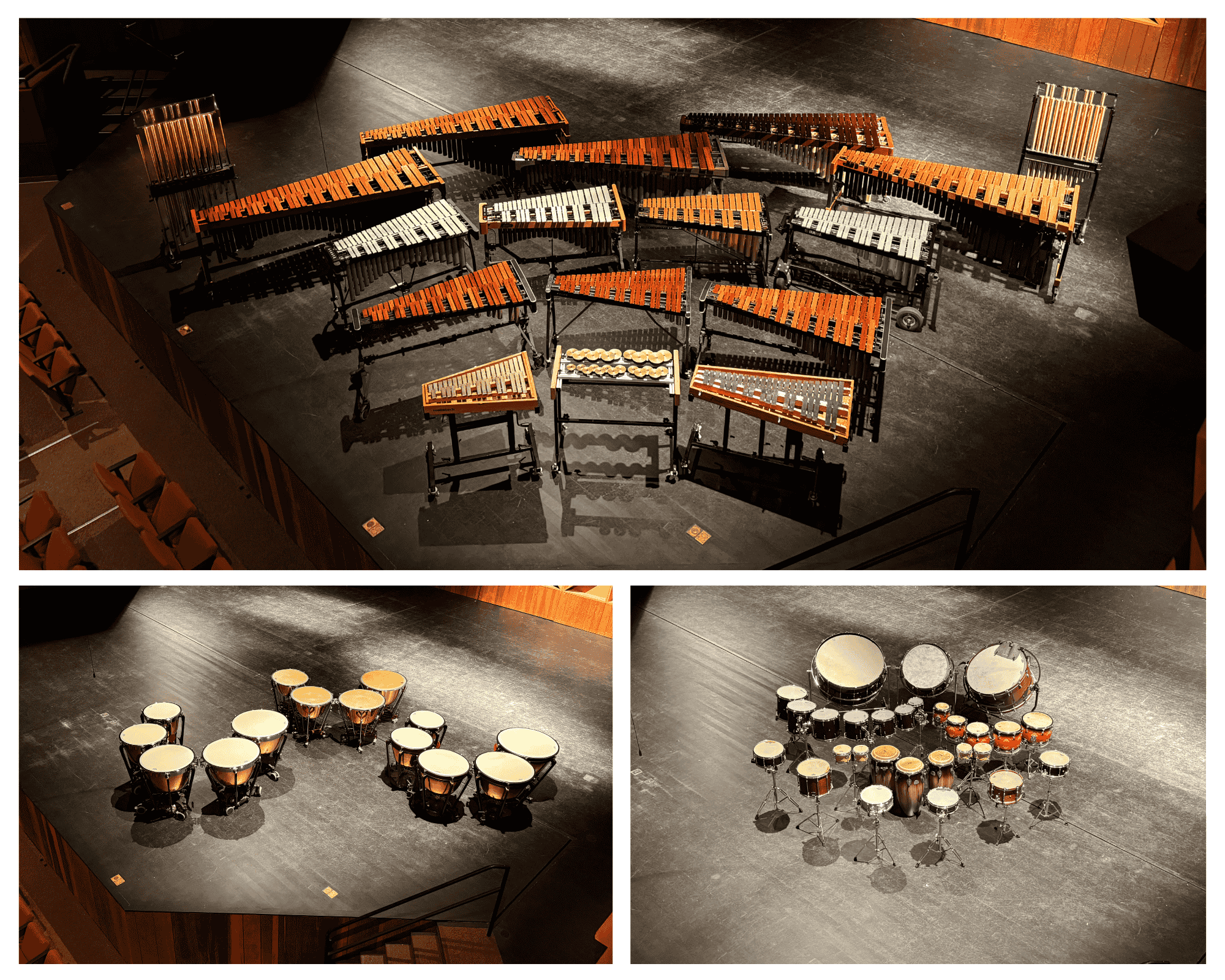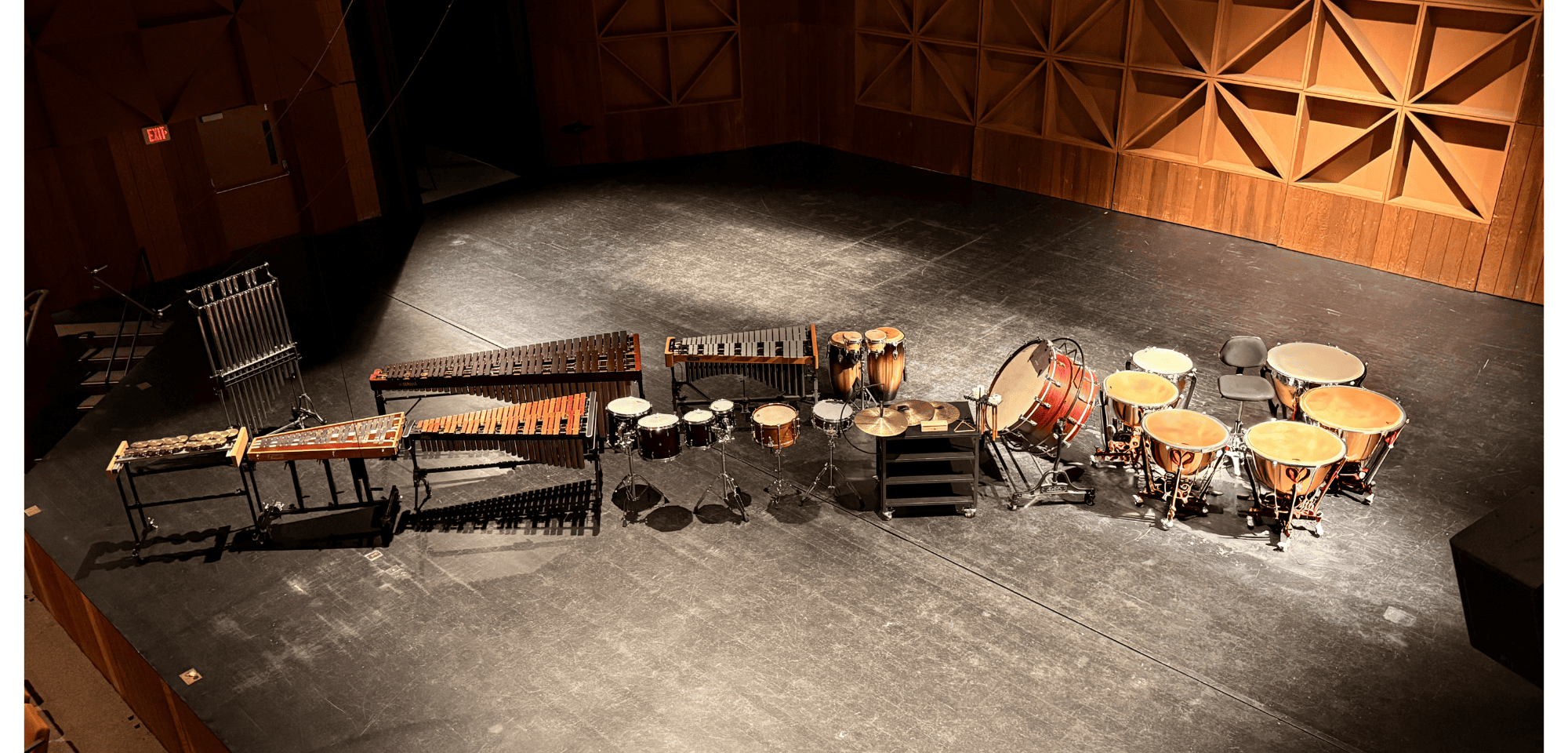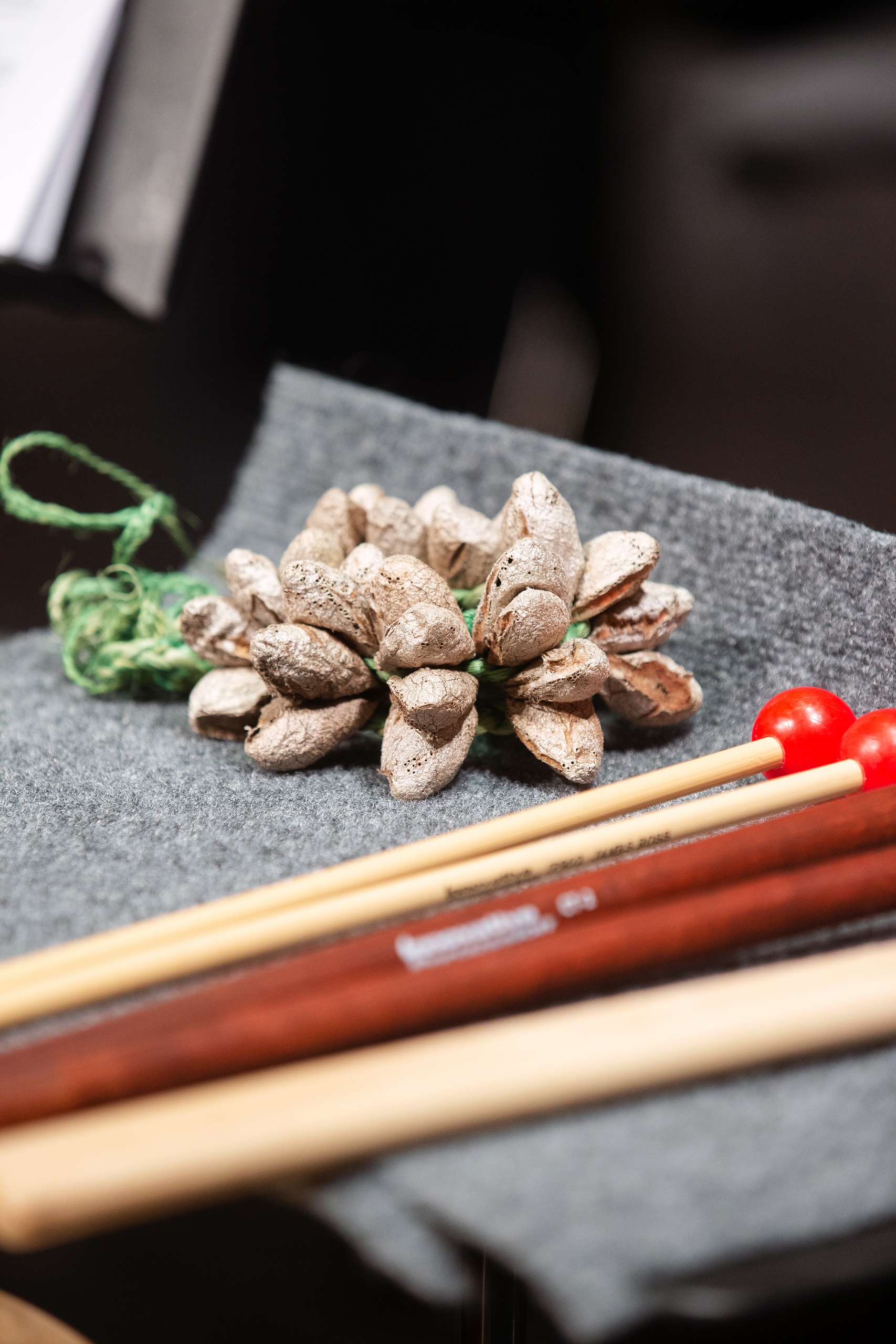Prospective Students
UNDERGRADUATE AUDITION REQUIREMENTS
Percussion (Music Education, Performance, BMA)
Students auditioning for admission into the percussion studio are expected to perform at least three prepared pieces in the following areas:
- Concert and/or Rudimental snare drum (ex: Cirone, Peters, Pratt, Wilcoxon)
- Two and/or four mallet marimba (ex: Goldenberg, Hatch, Green, ZIvkovic, Sammut, Peters, Smadbeck)
- One of the following areas:
- Timpani (ex: Firth, Goodman, Peters, Campbell)
- Multiple percussion (must be submitted electronically. Ex: Peters, Kraft, Tagawa, Glassock)
- Drum set (prepared solo and/or style demonstration: rock, swing, latin, etc.)
Students will also be asked to sight-read on snare drum and keyboard percussion.
A list of suggested audition repertoire can be found at this link under "Suggested Audition Repertoire".
Students should provide copies of their prepared pieces at their audition.
Please contact Dr. Daniel Piccolo with any questions: dpiccol@bgsu.edu
Jazz Percussion
Students auditioning for admission into the jazz studies program are required to perform the following material on drum set:
- Style demonstration: medium swing, up swing, shuffle, waltz, Bossa nova, samba, mambo, rock, funk
- Sight-read a big band chart
- Scales and sight-reading on keyboard percussion
- Optional materials (encouraged, but not required)
- Prepared drum set solo
- Transcription
- Prepared marimba/vibe solo
Please contact Dr. Daniel Piccolo with any questions: dpiccol@bgsu.edu.
MASTERS OF MUSIC AUDITION REQUIREMENTS
Percussion
Students auditioning for the Masters program in percussion are expected to perform at least five prepared pieces in the following areas:
- Concert and/or Rudimental snare drum (ex: Delecluse, Tompkins, Peters, Markovich)
- Four mallet marimba (ex: Stout, Abe, Druckman, Miki, Maslanka)
- Timpani (Carter, Delecluse, Lepak, Bergamo)
- Any two of the following areas:
- Multiple percussion (must be submitted electronically. Ex: Xenakis, Kraft, Lang, Kitazume, Cangelosi)
- Vibraphone (ex: Bach, Deane, Zivkovic, improvisation on a jazz standard)
- Orchestral Excerpts (two contrasting excerpts on each of the following: snare drum, timpani, xylophone, and glockenspiel)
- Drum Set (prepared solo and/or style demonstration: rock, swing, latin, etc.)
A list of suggested audition repertoire can be found at this link under "Suggested Audition Repertoire".
Students should provide copies of their prepared pieces at their audition.
Please contact Dr. Daniel Piccolo with any questions: dpiccol@bgsu.edu.
DOCTOR OF MUSICAL ARTS AUDITION REQUIREMENTS

Widely known as one of the country's outstanding collegiate music programs in music education and contemporary music, the College of Musical Arts prepares students to be educators, performers, and scholars on an international level. Celebrated faculty members position students to live and achieve their passion, and our unique contemporary music program has inspired alumni to Pulitzer and Grammy level achievements.
- Students receive individualized instruction in the Moore Musical Arts Center—one of the nation's finest music facilities—which has a state-of-the-art computer lab and music technology and recording studios.
- Nearly 60 full-time faculty are active teachers, scholars and performers with national and international reputations.
- Music ensembles—orchestra, bands, choirs, small groups and world music ensembles—are open to all University students (some by audition).
- The residential Music Community and the Arts Village Residential Community are conveniently located across the street from the Moore Musical Arts Center.
- Approximately 90 scholarships are offered annually to incoming students to recognize musical and academic achievement.
The College of Musical Arts offers several degrees and programs in multiple areas as follows:
Examples of Appropriate Undergraduate Audition Repertoire:
- Snare Drum
- Mitchell Peters—Intermediate or Advanced Snare Drum Studies, any etude
- Anthony Cirone—Portraits in Rhythm, any etude
- John Pratt—14 Modern Contest Solos, any solo
- Charley Wilcoxon—The All-American Drummer, any full-page solo
- Warren Benson—Three Dances, any movement(s)
- Michael Colgrass—Six Unaccompanied Solos, any movement(s)
- 2-mallet Marimba
- Morris Goldenberg—Modern School for Xylophone, any of the roman numeral etudes
- George Hamilton Green—The Xylophone Rags of George Hamilton Green, any rag
- Earl Hatch—Furioso and Valse in D minor
- J.S Bach—Violin Concerto in A minor
- 4-mallet Marimba
- Alice Gomez—Rain Dance, Mbira Song
- Mitchell Peters—Yellow After the Rain, Sea Refractions
- Julie Davila—Impressions on Wood, any solo
- Eric Sammut—Rotations 1-4
- Paul Smadbeck—Rhythm Song
- Keiko Abe—Frogs, Memories of the Seashore
- Gordon Stout—Two Mexican Dances
- Timpani
- John Beck—Sonata for Timpani
- Richard Hochrainer—Etuden for Timpani, any etude
- Saul Goodman—Goodman Timpani Method, any etude beginning with No. 29
- Vic Firth—The Solo Timpanist, any solo
- Multiple Percussion
- William Kraft—French Suite, any movement(s)
- William Kraft—English Suite, any movement(s)
- Rickey Tagawa—Inspirations Diabolique, Amy movement(s)
- Mitchell Peters—Introduction & Waltz
- Drumset
- Latham—Advanced Funk Studies
- Sanderbeck—Homage to Max
- Riley—The Art of Bop Drumming, any play-along track
- Morgan—The Jazz Drummer’s Reading Workbook , any play-along track
Examples of Appropriate Graduate Audition Repertoire:
- Snare Drum
- Mitchell Peters—Advanced Snare Drum Studies, Hard Times, any etude
- Jacques Delecluse—Douze Etudes, any etude
- Michael Colgrass—Six Unaccompanied Solos, any movement(s)
- Warren Benson—Three Dances for Solo Snare Drum, any movement(s)
- Joseph Tompkins—9 French-American Rudimental Solos, any etude
- Any work by Mitch Markovich
- 4-mallet Marimba
- Abe—Dream of the Cherry Blossoms, Michi
- Rosauro—Concerto for Marimba – Rosauro
- Maslanka—Variations on Lost Love, My Lady White
- Miki—Time for Marimba
- Stout—Two Mexican Dances, Astral Dance
- Druckman—Reflections on the Nature of Water
- Sejourne—Concerto for Marimba and Strings
- Honstein—Hymning
- Sammut—Three Spirals, Libertango
- Burritt—October Night, Four Movements for Marimba, Chameleon
- Vibraphone
- Deane—Mourning Dove Sonnet
- Friedman—Selections from Mirror from Another
- Molenhoff—Selections from Music of the Day
- J.S. Bach—Sonatas and Partitas for Violin
- Zivkovic—Suomineito
- Improvised solo over a form
- Timpani
- Carter—Eight Pieces for 4 Timpani
- Delecluse—Vingt Etudes for Timpani
- Bergamo—Four Pieces for Timpani
- Zegalski—30 Etuden for 4 Pauken
- Multiple Percussion
- Iannis Xenakis—Rebonds
- Michio Kitazume—Side by Side
- Cangelosi—Wicca, Ogre Ballet, Evil Ernie
- Hollinden—Cold Pressed
- Kopetzki—Canned Heat
- William Kraft—French Suite, any movement(s)
- William Kraft—English Suite, any movement(s)
- Rickey Tagawa—Inspirations Diabolique, Amy movement(s)
- Drumset
- Latham—Advanced Funk Studies
- Sanderbeck—Homage to Max
- Hollinden—Six Ideas for Snare, Bass and Cymbal
- Riley—The Art of Bop Drumming, any play-along track
- Morgan—The Jazz Drummer’s Reading Workbook , any play-along track
- Orchestral Excertps
- Xylophone
- Porgy and Bess, Gershwin
- Colas Bruegnon, Kabalevsky
- Hary Janos, Kolday
- Polka, Shostakovic
- Symphony No. 3, Schuman
- Appalachian Spring, Copland
- Glockenspiel
- The Sorcerer’s Apprentice, Dukas
- The Magic Flute, Mozart
- Pines of Rome, Respighi
- La Mer, Debussy
- Waldweben, Wagner
- Snare Drum
- Capriccio Espagnol, Rimsky-Korsakov
- Scheherazade, Rimsky-Korsakov
- Lt. Kije Suite, Prokofiev
- Peter and the Wolf, Prokofiev
- Symphony No. 3, Schuman
- Clarinet Concerto, Nielsen
- Bolero, Ravel
- Timpani
- Symphony No. 7, Beethoven
- Symphony No. 5, Beethoven
- New England Triptych, Schuman
- Symphony No. 4, Tchaikovsky
- Overture from Candide, Bernstein
- Symphonic Metamorphasis, Hindemith
- William Tell Overture, Rossini
- Xylophone


The College of Musical Arts at BGSU boasts an immense and diverse collection of percussion instruments.
- Adams Alpha Series 5.0 Octave
- Adams Artist Classic 5.0 Octave
- Adams Artist Classic 5.0 Octave
- Yamaha 5100 Professional Rosewood 5.0 Octave
- Marimba One Soloist Series 5.0 Octave
- Musser 4.3 Octave
- Musser 4.3 Octave
- Deagan 4.3 Octave
*All 5.0 octave marimbas are height adjustable
- Walter Light Mark VII Custom - 23", 25", 28", 30"
- Walter Light Mark VI - 26", 28"
- Adams Symphonic - 20", 23", 26", 29", 32"
- Adams Professional - 23", 26", 29", 32"
- Ludwig Professional - 18", 20", 23", 26", 29", 32"
- Ludwig Universal - 23", 26", 29", 32"
- Pearl Philharmonic Nickle Brass 14x5
- Pearl Philharmonic Aluminum 14x5
- Pearl Philharmonic Maple 14x8
- Black Swamp Maple 14x5
- Pearl Aluminum Pancake 14x3
Updated: 06/09/2025 06:39PM

